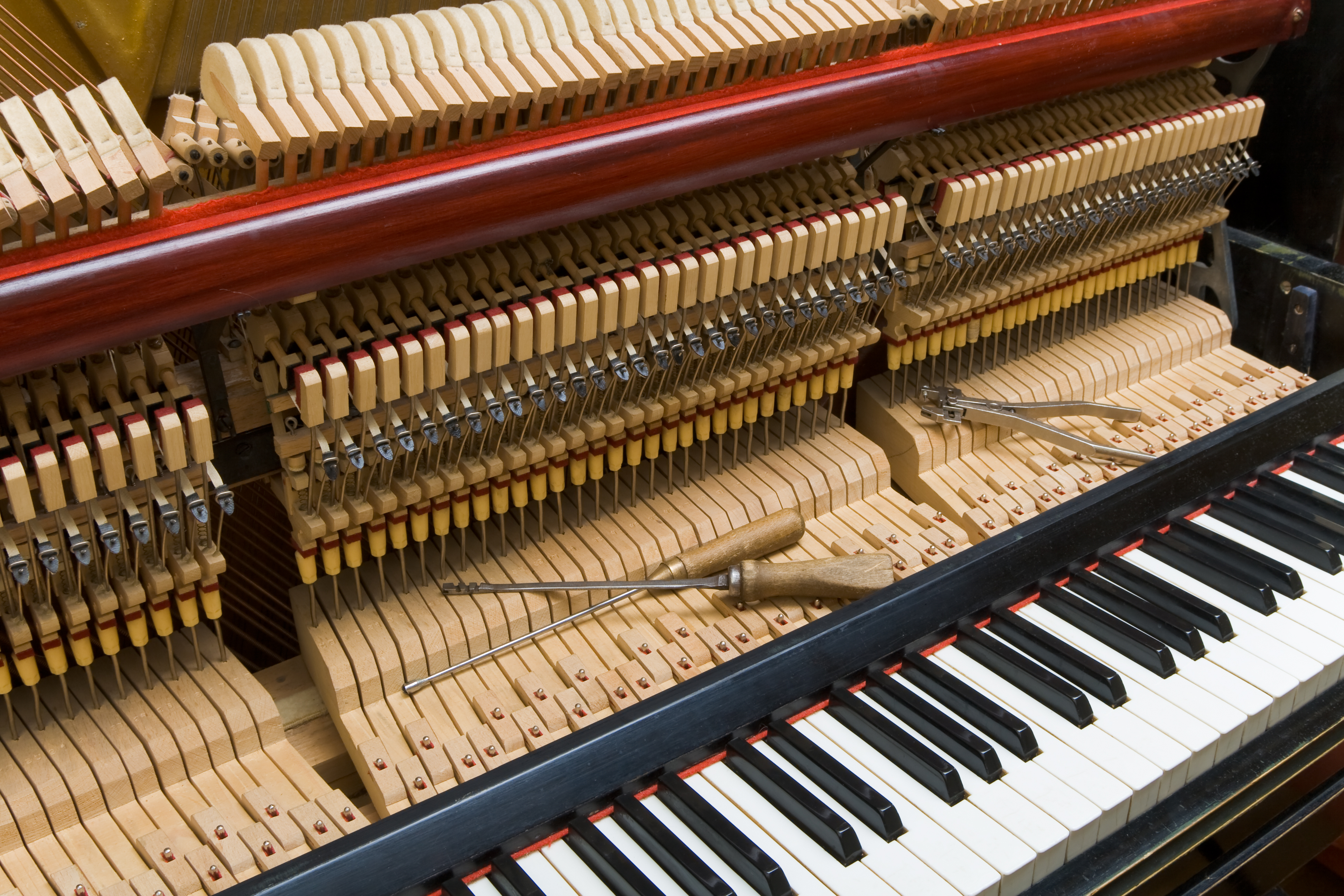
There are piano tuners and then there are piano technicians, also known as piano doctors or piano surgeons. Anyone can tune a piano with today's technology, and virtually anyone can advertise themselves as a piano tuner. Neither piano tuners nor piano technicians go to four year universities to get their training like most other professions.
So, what exactly is the difference between a piano tuner and a piano technician and who do you want working on your piano?
A piano has over 3000 parts. Tuning the piano is rather minor when you consider this. A piano tuner does one thing, tunes the piano. Most people who fall into this category will generally use electronic devices to let them know when the string is in tune. They may or may not have amateur knowledge on a few repairs on the piano, but it would be wise to not really let them tinker around with your piano. In fact, I could say I am a piano tuner!
However, a piano technician does much more than just tunes your piano; they repair, enhance, recondition, and restore. I would never state that I am a piano technician.
A great technician will be able to work on any piano, regardless of condition, and should be able to bring any piano back to life. With that being said, an honest technician will tell you if your piano isn’t worth fixing; sometimes the amount of work that is required will cost far more than the instrument itself is worth. However, if the piano has an extreme amount of sentimental value to you and you wish to have it repaired, the technician should understand and get the job done. Ultimately, these “piano doctors” are supposed to be passionate about healing sick pianos and bringing them back to a healthy life.
In this article, I will discuss how to find a skilled technician, the main areas a skilled technician will often look at when working on a piano, and will provide you with some advice on how to test your piano to ensure that it is in full working order. This will provide you with some insight to whether you or not you have a good technician. After all, it is vital that pianists establish a good relationship with a passionate technician that they can trust.
1. How to Find a Technician
Before we get into the specifics, let’s identify the easiest ways to find a technician in your area.

a) Piano Technicians Guild
Although there is no college program, there is a place where piano technicians can become certified; this place is known as the piano technicians guild.
At the guild, people take three exams. One is written, and the other two consist of a field test and a tuning test.
During the field test, the applicants must work on both an upright and a grand piano. The written exam consists of 100 multiple choice and true/false questions. The field exam requires the applicant to regulate different actions and operate on field repairs.
For the tuning exam, they must take an out of tune piano, that has strings both sharp and flat, and bring it to a “master tuning” level. If they pass these exams, they become a recognized, registered piano technician under the guild. If they score a 90% or higher, they will become a certified piano tuner and reviewer. This allows them to conduct tests themselves for the guild.
You can call the Piano Technicians Guild and ask for the certified technicians in your area. However, getting a tuner from the piano technicians guild can be a bit risky. Why? Once they pass the exams, they are in the guild for life, regardless of how long it has been since they passed their exams.
When I first purchased my grand piano, I called the technicians guild to find a registered technician in my area. I asked for the individual who scored the highest on their exams. When this person came, although they were incredibly knowledgeable, much had changed over the 30+ years for them since the time he/she took their exam.
Everyone’s story is different, and this particular person’s experiences over the years changed their mental mindset. And as a result, the job I hired them to do, which was a big one, was not done very well. In fact, there was some very minor damage done to my piano.
b) Referral
The best way to avoid the experience I had is to try to get a referral from a technician or musician that you trust. Generally this is your best weapon. If you go to concerts and you believe the piano sounds great, try to find out who they hire as a piano technician. Every concert hall, whether it be a professional hall, university, or conservatory, has a technician on contract.
c) Recommendation from Piano Manufacturer
You can also call the company who makes your piano. They will have a handful of technicians on call in your area. Generally all these technicians will be strong as well, because they help represent and take care of their brand.
2. Piano Technician Basics
Although I am not a piano technician, I do know the basics. I learned through many hours of discussion, observation, and hands on learning with some of the best technicians in my area. These are are most basic steps to ensure that your piano is singing to its fullest potential.
Cleaning: Removal of Dust
Believe it or not, dust can have a huge effect on your piano’s tone. The strings are made out of tempered high carbon steel and over time, micro-dust particles settle on the strings and soundboard. The soundboard becomes coated over time with dust, which greatly reduces projection and overall tone quality from the board. This is where the piano breaths and speaks from. Imagine if you had a layer of dust over your nose when trying to breath or over your mouth when trying to speak. If your piano is coated in dust and your tuner completely ignores this, either A they don't care or B they don’t understand this themselves. Experienced technicians generally have their own portable cleaning system and vacuum cleaners.
a) Strings
After about 20-30 minutes of playing, dust and microscopic particles begin to find a nice spot to rest on the strings. Once you clean the dust off your strings your tone will greatly improve. Its surprises me every time and it's quite odd that something this minor can have such a major effect on your pianos tone.
It's generally advised to use both a MicroFiber Cloth to first wipe down your strings, followed by many strokes from a 100% nylon brush. The microfiber cloth scrubs away at any dust particles that have been resting for quite some time on the strings, and nylon attracts any left over loose dust. After that you can vacuum the strings too with the brush or long arm attachment.
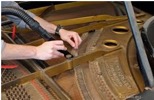
b) Sound Board
For the soundboard, a giant swiffer duster will do the trick. It's advised that you first clean the strings because dust particles will fall onto the soundboard during that process. Make sure to swiffer the whole soundboard and all the little passageways throughout the board. Always remember, this is where the piano speaks.
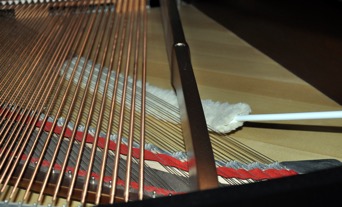
Hammer Work
Hammers are the second biggest factor which affect how the piano sounds. Hammers are made of felt. The felt is pretty tough, but over time grooves will develop. Look at your hammers. Healthy hammers will be be rounded and have no grooves in them. If your hammers have deep grooves in them, they need to be filed. Once again, an educated, experienced piano technician will know whether or not the hammers need work just from listening to the instrument being played. They won’t even have to look because the tone difference is so evident. How exactly do piano technicians fix this problem?
a) Filing Grooves
The images below shows piano hammers that have been flattened out, with grooves in them. You technician will file these hammers with different grits of sandpaper, starting low and then going higher, to work out the grooves, and then smooth, or polish the felt. It's pretty simple, but can take a few hours.
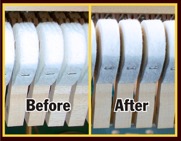
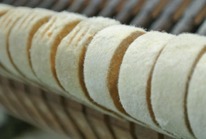
b) Mating to the string
After the hammers are filed, the technician needs to mate the hammer to the string. If your technician does not follow up with this process, then your technician is skipping a major step! Mating the hammer to the string makes sure that the hammer strikes all three of the strings at once when the key is pressed. Why is this so vital? Because if the hammer is not mated correctly, it will not strike all the strings evenly. This has a huge affect on your piano’s tone by creating a thud sound.
You have heard this sound already, although most likely not as prevalent, if you have ever listened to a piano being tuned. The technician puts felt in between the strings, or a rubber mute, so he/she can listen to two strings at once to tune them to a unison pitch.
Mating the strings is done by putting the action into the piano and then taking a metal hanger, or something similar in nature, and manually lifting the hammer to make contact with the string. Then they will take a guitar pick, or use their nails, and strum the strings individually. All three strings should die in sound almost instantly because there is a hammer resting under them. However, say two strings die, the left and the middle, but one sustains, the right, then the technician knows the hammers felt is a bit higher on the left side. They should then take the action back out and give the left and middle side a little bit more filing to level the hammer, and then test it again. This has to be done for every hammer. Note: Since the bass notes only have 1 string, it is not as vital that the strings are mated.
c) Voicing
After the hammers are filed and mated, voicing is the last process. Voicing is subjective and the point of voicing is to make sure that the piano sounds good for the room it is in. Voicing makes the hammers softer or harder. To make the hammer softer, your technician will poke little holes throughout the hammer to allow the felt to expand. This will make a very bright/harsh tone become more round. If your hammers are too soft then a chemical will be applied to them to harden the felt. This will make a dieing/dead tone become more narrow.
Action - Testing the Keyboard
A good technician will sit and play all 88 keys chromatically, starting at the low A - all the way up to the high C, and during this process, they will be checking that: there is no clicking sounds in the keys, all the keys are falling around the same depth, all the hammers are striking the strings, and the keys are resetting at the same rate, while listening to the overall tone of the piano. No great technician will learn all this information about the instrument after one chromatic playthrough. Often they will check individual keys, octaves, thirds, and play a little bit too, in order to feel the overall response of the instrument. If your tuner sits down, plays all 88 keys chromatically, and looks at you smiling and says “everything is good,” you more than likely have an inexperienced tuner, or someone who is more interested in accepting your money than working on the piano.
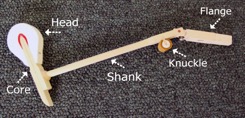
If you piano action has issues, your technician will pull out the action and do a series of tests. The most basic test is removing one of the hammers, by taking out the screw in the flange, and testing how many times the hammer swings. Hammers are connected to the rest of the action with a screw. They will unscrew a hammer, and then hold it upside down from where the screw is placed. A healthy hammer will swing 5-7 times. This will let them know if the felt around the pin in the flange is too swollen or too compressed. If the flange is too loose or tight, the tone of the piano and overall response of the action can be greatly affected. There are also many screws, nuts, and bolts throughout a piano’s action. It is vital that all of these are polished and look new. If they are old and coated with dirt or rust, they need to be cleaned or replaced.
Tuning
Finally we get to tuning.
Tuners turn the tuning pins with a special lever, and although it looks really easy, there is some technique to it. The tuner has to tune the pitch a little sharp first, and then center the pitch. This assures that the tuning pin doesn’t torque.
Technically pianos aren’t perfectly in tune; if they were they would sound rather dull. Instead, pianos are almost always tuned to equal temperament.
Generally the higher the octave, the more sharp it gets. Piano technicians measure this difference in cents. If you ever used or messed around with synthesizer oscillator pitches, you are probably already familiar with this term.
Technicians will tune a piano one of two ways, or both: with a tuner and by ear.
Now experienced technicians aren’t using a mobile app to tune your piano, or even computer software.
Generally, they use a very expensive, sophiscated tuner known as a Sanderson Accu-Tuner IV. These are sold at around $1600 USD. Now keep in a mind a great technician is not going to rely 100% on a tuner. They use it generally to guide the first couple pitches and do the rest by ear.
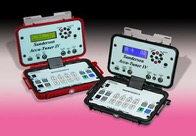
Some techs won’t even use an electronic tuner, and prefer to use a tuning fork to get their first pitch. They will either start in the middle of the keyboard and work their way around, or start at the low octaves and work their way up.
3. Testing the Tuning Job
After the technician is done with your piano, which depending on how much work is needed can take up to a couple weeks, it's time to test it for yourself. Generally you should do this while the technician is present, so if are you unhappy you can let them know. It will also help educate them too on your perspective since after all, it's very subjective.
For starters, listen for unisons. The pitch should stay stable for at least two seconds. If there is a roll off after two seconds it could be as simple as the wire is old, or needs some basic cleaning. If the wire is very old then you could replace them, however a new set of strings will generally start at around $3,000 and takes a few months before the strings settle. If you play a note and there is a morphing of the sound, also known as phase issue, almost instantly, then the strings are not in tune with each other. Play octaves throughout the whole keyboard, chords, thirds, sixths, tritones, etc. Once again, everything should stay stable for at least two seconds. The expression used when a piano is really in tune is: “The Heavens Are Opening Up.” In other words, the overtones are really projecting, and playing something as simple as a major tenth can sound amazing.
If your ears are new, or you aren’t necessarily confident in your ears, you can always download a mobile app to do some rough checks. Remember the piano may appear a tad bit sharp on the tuner for some notes, and this is so the piano projects when playing multiple octaves at once. Next is the action. None of your keys should be sticking and there should not be any clicking sounds no matter how hard you strikes the keys. Try playing the same key repeatedly as fast as you can. Your piano should be able to keep up with even the fastest fingers.
Final Thoughts
In conclusion, your experience with a piano technician should be great, inspiring, and someone with lots of knowledge and experience should open up your mind to a new set of philosophies on the piano.

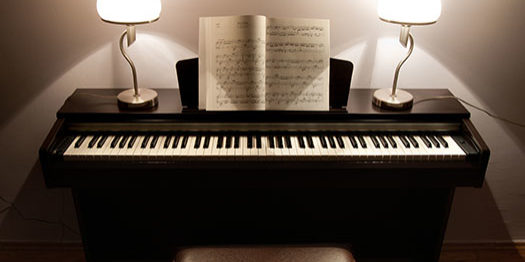
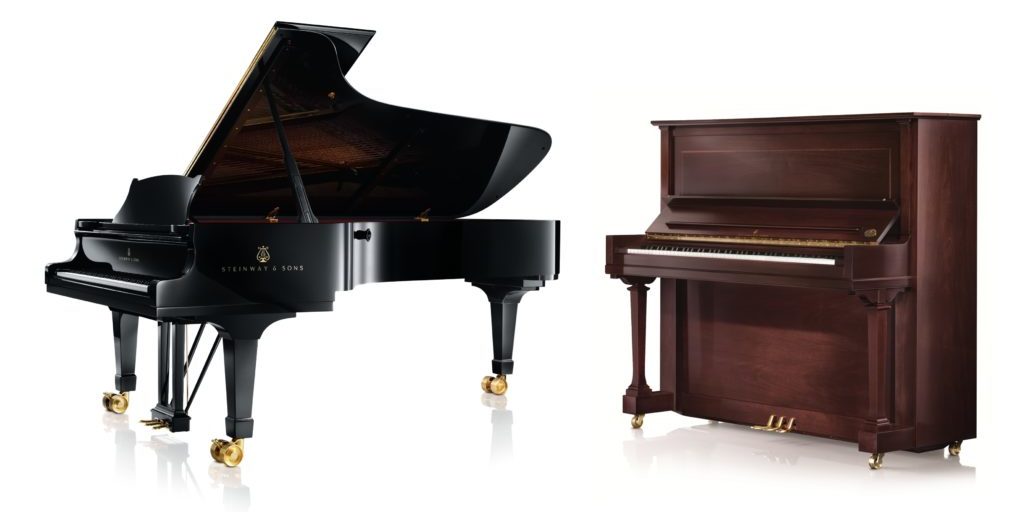


After my piano was tuned it sounds ‘tinny’ almost has that sound of old player pianos. I don’t know what the tuner did to cause that. I sure would like it changed back. What should I do?
Hey Jennifer,
If your pianos tone became thinner after the tuner tuned it, it may be a result of the tuner tuning all the octaves to the exact frequencies; in other-words, the tuner tuned your piano to a “pure tuning.” Pianos are technically not in tune. The word inharmonicity is the word we use when talking about piano strings. In result we have to tune the higher partials slightly sharper to help widen the sound.
Did your tuner use an electronic tuner when they tuned? And if so, did you get a chance to see what type of electronic tuner they used?
He didn’t use an electronic tuner.
Jennifer,
I would recommend calling him, and expressing what you dislike about the tuning job. Tell him what you would like to change. If he isn’t really willing to listen, or adapt to your needs, than I would try to find a new technician.
I am a tech. I’ve had people over the years that would say similar things.
1st question- how long had your piano went between tunings? If it had a pitch raise.then it will sound unsettled. Some people say that it must have been voiced up, sounds “brighter”. That’s because the pitch is higher and cleaner.
Most people think they way more about a piano than they actually do! Even people who are around them all the time, piano teacher, piano sales person, pianist for church etc.
The tuner may not have done a good job on the unisons.
This can make it sound “tinny” or like an “old player piano”.
In piano tuning unisons are truly the most important element. If unisons are not in tune the piano sounds overall out of tune. The thing is, there are three strings throughout the majority of the keyboard. If your tuning pins are loose then the unions could begin to go out of tune within 24 hours; 3-5 days later and the begins to become much more evident. When did you begin to notice this? Right after the tuner left? Or did you begin to notice it say, a week later?
i love this write up. it really goes to show that tuning a piano is more akin to working on a large multilevel project then tuning a guitar. there are so many factors that can go into why a piano falls out of tune. i have started a paino tuning service in my home town and i see people try and tune their piano after watching few YouTube videos. You can really damage the your instrument if you don’t know what you are doing. Pianos hold so much tension and you need to understand how the wires reacted to that tension before you tune. Thanks a ton
Shane,
Thanks for the comment. I agree you with 100%. A great technician is like a great car mechanic; its just a different form art. Tuning harmonic strings is much different, and a tuner will pretty much get you 95% there. After that, I personally feel that some fine adjustments should be made with you ear. Do you have any experience with a Floyd Rose? I built a guitar, but I can’t quite figure out how to get the intonation secured for more than an hour with .11 gauge strings. Maybe I just play too hard, haha!
The link to your website does not load.
The more I learn about pianos intonation, the more I feel like I should stop learning about piano intonation. Its like you said, there are so many factors, and some of the overall philosophies among technicians on “what even is an in tune piano,” can get insanely deep. Some of the best technicians I have met are quite bizarre; at least to me.
Yes piano tuners can be an odd bunch! and i think you are right about the question “what even is an in tune piano?” because most things you read and learn is that the instrument begins to fall out of tune almost immediately. not sure why the link to my website didn’t work hopefully this time it does!
Hey,
Nice website!
I have a question for you. If my unisons go out of tune rather quickly, say within a few days after I get it tuned, is this a result of old strings, loose tuning pins, or both? I have a Yamaha C3 from 1987.
Thanks for explaining how you can be sure if a piano is tuned properly. You mentioned that it could be good to dust off your strings. I’m interested to learn if this should be done right before you play or if it depends on other factors.
Every-time you play the piano, even if its just one note, micro fibers from the hammer break apart, go into the air, and inevitably settle onto the strings and soundboard. If you play very hard, or for a long period of time, this affect will obviously be greater. There’s nothing you can do to prevent this other than regular cleaning. Depending on how often you wish to clean your instrument is entirely up to you. If I had a brand new piano, like straight from the factory, I would probably clean it every other day; sort of like the feeling you have when you buy a new car. However, my piano is from the 80’s, and the previously owner smoked, like a lot. My tech said to me, “Steve, this piano was a smoker!” when he saw it. There was actually an accumulation of tar on the soundboard in the treble strings, most likely where the ash tray was. It took me a long time to scrub it out. But the tar on the strings is permanent. So I only dust it once a week, sometimes every other week.
I’m not going to sit here and lie to you by saying that if you dust your strings your pianos tone will become this new great thing. It really depends on how dusty your strings are, and how sensitive your ears are. If you haven’t dusted your piano in years, then yeah just about everyone will hear the difference, but if you clean it regularly then the difference will be rather subtle. Before a major concert though, I can guarantee you that the piano is not only is going to be tuned, but it will also be cleaned. Most techs will take out the keyboard and lightly, and I mean lightly, apply some high grit sand paper to smooth out any impurities in the hammers. After this they will blow away all the loose fibers and dust with compressed air, or a reverse setting on their vacuum cleaner, vacuum the whole piano after that, and then dust the strings again, and then the soundboard.
So, to answer your question … it really depends on how intense your OCD is! If you want to clean it before you play it, then go for it!
thank you for this amazing article this helps me a lot
Thank you for the comment!